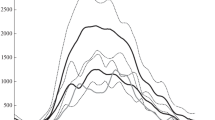Abstract
The anomalous increase in the area of the 23rd solar cycle detected by galactic cosmic rays (GCRs) was a precursor of failure of the 11-year cyclicity: in accordance with the author’s hypothesis about the invariant of the 22-year cycle, an increase in the area of the 23rd cycle was followed by a decrease in the area (energy intensity) of the next 24th cycle. A decrease in energy intensity is accompanied by a decrease (relative variation) in the luminosity of the Sun, which in the 24th cycle has decreased to the level of the average value of the three previous cycles, i.e., almost twice. If the invariant of the 22-year cycle is preserved, the restoration of the 11-year cyclicity in the 25th cycle should be expected. If the invariant of the 22-year cycle is violated, the level of the GCR radiation background at the maximum of the forthcoming 25th cycle (from 2024 to 2025) should not be lower than the background radiation level at the maximum of the 24th cycle (2014). In this case, the state of the 23rd–24th–25th cycle unusual failure will change from local to global.




Similar content being viewed by others
REFERENCES
Carbonel, M., Oliver, L., and Ballester, J.L., A search for chaotic behavior in solar activity, Astron. Astrophys., 1994, vol. 290, no. 3, pp. 983–994.
Mikhailutsa, V.P. and Fat’yanov, M.P., Dimension and structure of the solar attractor based on the energy of the solar magnetic field in cycle 21, Soln. Dannye, 1989, no. 11, pp. 109–116.
Kozlov, V.I., Scale invariance of cosmic ray fluctuation dynamics at the geoeffective phases of the solar cycle, Geomagn. Aeron., 1999a, vol. 39, no. 1, pp. 95–99.
Kozlov, V.I., Estimation of the scaling properties of the dynamics of cosmic ray fluctuations in the solar activity cycle, Geomagn. Aeron., 1999b, vol. 39, no. 1, pp. 100–104.
Potapov, A.A., Fraktaly v radiofizike i radiolokatsii (Fractals in Radio Physics and Radar Ranging), Moscow: LOGOS, 2005.
Kozlov, V.I. and Markov, V.V., Wavelet image of the fine structure of the 11-year cycle based on studying cosmic ray fluctuations during cycles 20–23, Geomagn. Aeron., 2007, vol. 47, no. 1, pp. 43–51.
Kozlov, V.I. and Kozlov, V.V., Aritmiya Solntsa. V kosmicheskikh luchakh (Arrhythmia of the Sun. In Cosmic Rays), Yakutsk: Izd. Inst. Merzlotoved., Inst. Kosmofiz. Issled. Aeron., Ross. Akad. Nauk, 2016.
Kozlov, V.I., Basis for forecasting solar activity based on cosmic ray monitoring, Vestn. Severo-Vost. Fed. Univ., 2018, vol. 6, no. 68, pp. 68–80.
Dennis, B.R., Solar hard X-ray bursts, Sol. Phys., 1985, vol. 100, pp. 465–490.
Bak, P., Tang, C., and Wiesenfeld, K., Self-organized criticality, Phys. Rev., 1988, vol. 38, no. 1, pp. 364–374.
Bak, P., How Nature Works. The Science of Self-Organized Criticality, New York: Springer-Verlag, 1996.
Podlazov, A.V. and Osokin, A.R., Self-organized criticality of eruptive processes in the solar plasma, Matem. Mod., 2002, vol. 14, no. 2, pp. 118–126.
Zelenyi, L.M. and Milovanov, A.V., Fractal topology and strange kinetics: from percolation theory to problems in cosmic electrodynamics, Phys. Usp., 2004, vol. 47, no. 8, pp. 749–788.
Aivazyan, S.A., Enyukov, I.S., and Meshalkin, I.D., Prikladnaya statistika. Osnovy modelirovaniya i pervichnaya obrabotka dannykh (Applied Statistics. Basics of Modeling and Primary Data Processing), Moscow: Finansy i Statistika, 1983.
Yazev, S.A., Activity complexes on the sun during the 23rd solar cycle, Geomagn. Aeron., 2011, vol. 51, no. 7, pp. 879–887.
Mordvinov, A.V., Yazev, S.A., Lkhagvazhav, Ch., and Batmunkh, D., Activity complexes and structure of the large-scale magnetic field of the Sun in cycle 24, Sovrem. Geodin. Opasn. Prir. Protsessy Tsentr. Azii, 2011, no. 7, pp. 10–15.
Mordvinov, A.V., Golovko, A.A., and Yazev, S.A., Activity complexes and magnetic field inversion at the Sun’s poles in the current cycle, Soln.-Zemnaya Fiz., 2014, no. 25, pp. 3–9.
Tlatov, A.G., Three-fold polarity reversal of the large-scale magnetic field of the Sun in the 24th cycle of activity and the forecast of the amplitude of the 25th cycle of activity, in Tezisy doklada na 9-i ezhegodnoi konferentsii IKI “Fizika plazmy v solnechnoi sisteme” (Abstracts of Papers at the 9th Annual Conf. of Space Research Inst. “Plasma Physics in the Solar System”), Feb. 10–14, 2014, p. 4.
Obridko, V.N. and Shel’ting, B.D., On the negative correlation between solar activity and solar rotation rate, Astron. Lett., 2016, vol. 42, no. 9, pp. 631–637.
Vitinskii, Yu.I., Kopetskii, M., Kuklin, G.V., Statistika pyatnoobrazovatel’noi deyatel’nosti Solntsa (Statistics of the Sunspot-Formation Activity of the Sun), Moscow: Nauka, 1986.
Krymskii, G.F., Cosmic rays and near-Earth space, Soln.-Zemnaya Fiz., 2002, vol. 2, no. 115, pp. 42–45.
Kozlov, V.I. and Kozlov, V.V., Aritmiya Solntsa. V kosmicheskikh luchakh (Arrhythmia of the Sun. In Cosmic Rays), Yakutsk: Izd. Inst. Merzlotoved., Inst. Kosmofiz. Issled. Aeron., Ross. Akad. Nauk, 2018, 3rd ed.
Panasyuk, M., Kalegaev, V., Miroshnichenko, L., et al., Extreme solar and geomagnetic conditions, in Extreme Events in Geospace: Origins, Predictability, and Consequences, Amsterdam: Elsevier, 2017, ch. 13. part 3, p. 358. https://doi.org/10.1016/B978-0-12-812700-1.00013-3
Kozlov, V.I. and Kozlov, V.V., Cosmic ray fluctuation parameter as indicator of 11-year cycle activity growth phase, J. Phys. Conf. Ser., 2013, vol. 409, id. 012160. https://doi.org/10.1088/1742-6596/409/1/012160
ACKNOWLEDGMENTS
The author is grateful to V.V. Kozlov for the development, creation, and software support of a robotic expert system for forecasting and diagnosing geoeffective space weather events in the online Cyber-FORSHOCK system (http://www.forshock.ru/pred.html) using 5-min data from the European Cosmic Ray Database.
The author also expresses his sincere appreciation and gratitude to I. Usoskin, University of Oulu, Sodankila Geophysical Observatory (Finland, http://cosmicrays.oulu.fi/), for kindly provided the conditioned 5-min measurement data of the neutron monitor at the Oulu station over a long period of time.
Author information
Authors and Affiliations
Corresponding author
Additional information
Translated by N. Topchiev
Rights and permissions
About this article
Cite this article
Kozlov, V.I. On the Probable Change of the Status of the Current Unusual Failure of 11-Year Solar Cyclicity from Local to Global. Cosmic Res 59, 71–79 (2021). https://doi.org/10.1134/S0010952521020040
Received:
Revised:
Accepted:
Published:
Issue Date:
DOI: https://doi.org/10.1134/S0010952521020040




